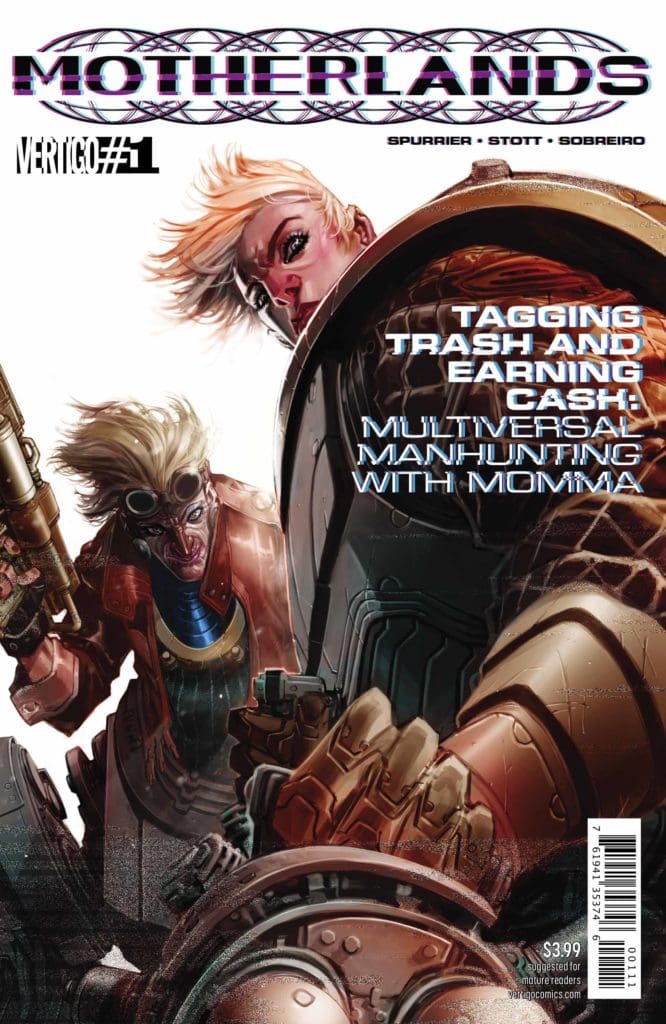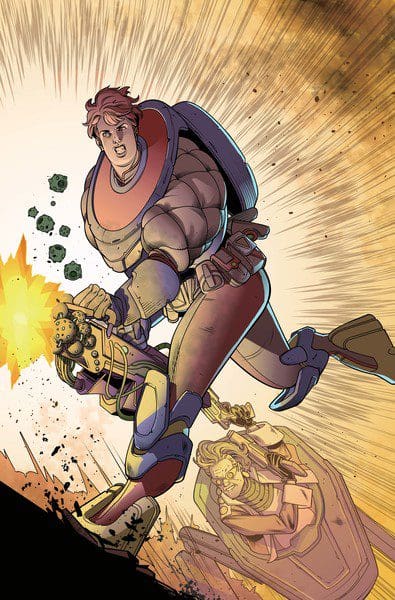Motherlands #1 is published by DC Comics under their Vertigo imprint. It is written by Simon Spurrier with art by Rachael Stott and colors by Felipe Sobreiro.
I want to start off by saying I thought the cover was a picture of a woman and a little old man who reminded me of Junkrat from Overwatch. However, it is, in fact, a woman and a little old woman, who still reminds me of Junkrat from Overwatch.
The first thing we see is the stick-figure drawing of a woman being stabbed to death. We then pan out to the young, delightful, bored little artist: Tabitha. She looks to be about five years old, in a class taught by floating discs. Which as we all know, is the sign of a terrible sci-fi future where humans have screwed up somehow. Spoiler: humans did screw up after discovering parallel Earths.
I’ll touch on the later. So Tabitha is called to the office by a teacher being followed by a GlaDOS-like floating ball (all small metal things float here so far) that is also a camera. A camera that is known for following Tabitha’s mother around, who is a famous celebrity, but not in our conventional standards. In this future world, celebrities are bounty hunters. Psychic ones at that. And this scene with young Tabitha and her high-strung mother pretty much set the stage for this comic, because their relationship is key.
Then the comic turns into an epic 80s sci-fi movie. With over the top action, like Tabitha in a big mech suit crushing a guy’s head and then proceeding to chase a hairy, naked man with only a metal belt on through various parallel dimensions. He stays naked. Yes, there are penis shots. Yes, it’s hilarious. Tabitha’s suit looks exactly like something you’d see in an 80s movie. At first, I thought her suit looked weird because it was so big. Turns out she’s genuinely huge.
The comic maintains this outlandish tempo right up to the end. Which is expected by Simon Spurrier. His writing for Power of the Dark Crystal is elegant and beautiful – but if you have read Godshaper or Angelic (which if you haven’t, you totally should) then you know just how out there he can get with the world and characters he weaves. One of my favorite things about Spurrier’s writing is his use of slang. When he creates a world, he truly creates a world.
There are phrases and terms that don’t exist here, but are just the language of this world. He doesn’t take time to explain what it means or the “old word” for it, he just puts it in to a sentence and scene and its up to us to figure it out from the context (it’s not hard).
I have seen Rachael Stott’s name before, I have seen her covers for Doctor Who. But I don’t read or even watch Doctor Who (Yes, I’ve already heard how great it is. What little I’ve seen, it’s pretty neat, but I have other shows to watch….mostly anime). So I wasn’t sure what to expect from Stott’s art. It’s fantastic. Just like Spurrier’s writing, Stott keeps up with the ridiculous world and characters. She gives them these exaggerated expressions, again, like an actor from an 80s movie would do, and in each parallel Earth we see, the scenery is completely different from the previous one.
The humans have such a variety of looks; humans who are half blob, humans with heads bigger than their bodies, humans multiple arms, humans with faces that look half melted, and so on. It’s also important to note that ALL of the beings in this book are humans despite how they may look. Stott takes time to insert subtleties into the background. Like the girl with an upside-down face who I had to do a double-take on because I almost missed it. And don’t think I didn’t see that Goku in the background either. Alongside Stott’s art is Felipe Sobreiro’s vibrant colors. Even when something is happening, you know exactly where to focus because Sobreiro points you right to it but still fills in noteworthy environments and characters.
OVERALL SCORE: 9 / 10
Make sure to pick up a copy of Motherlands #1 from your local comic shop! Happy reading!



